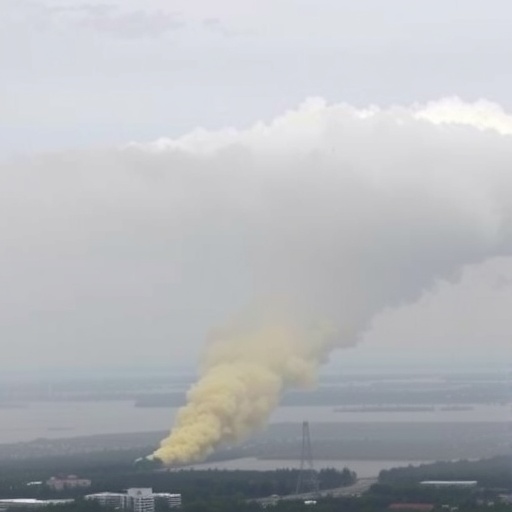In a groundbreaking development at the University of Warwick, researchers have unveiled a pioneering method to accurately predict how irregularly shaped nanoparticles navigate through the air. This advancement addresses a long-standing challenge in aerosol science, particularly concerning the behavior of airborne pollutants whose complex geometries have historically rendered their motion difficult to model. The newly introduced framework revives and significantly extends a century-old formula, opening the door for more precise environmental and health-related predictions.
Every day, humans involuntarily inhale myriad microscopic particles, ranging from everyday pollutants like soot and dust to bioaerosols such as viruses and pollen. Among these are engineered and natural nanoparticles small enough to penetrate deep into pulmonary pathways and even cross into the bloodstream, raising serious concerns about their contribution to chronic ailments including heart disease, strokes, and various cancers. However, the difficulty lies in their diverse and often irregular shapes, which defy conventional modeling assumptions traditionally based on idealized perfect spheres.
Conventional aerosol transport models have largely depended on the simplification that particles behave like spheres. This spherical presumption simplifies the fluid dynamic equations but falls short when applied to real-world particles exhibiting complex morphologies. Such oversimplification limits our ability to accurately predict how these particles disperse, settle, or interact within the atmosphere, thereby impeding reliable assessments of pollution distribution, disease vector dynamics, and atmospheric chemical processes.
The milestone now achieved by researchers at Warwick, led by Professor Duncan Lockerby, is the first to offer a computationally simple yet accurate method for describing the aerodynamic motion of particles irrespective of their shape. Published in the Journal of Fluid Mechanics Rapids, the study revitalizes the essence of the Cunningham correction factor—an early 20th-century innovation conceived to account for deviations in drag forces experienced by tiny particles moving slowly through gases.
The Cunningham correction factor, originating in 1910 and later refined by Nobel laureate Robert Millikan, had been traditionally confined to particles with spherical geometries. This limitation, unbeknownst to many in the field, arose due to subtleties lost during Millikan’s refinement where a broader generalization was overlooked. Professor Lockerby’s work revisits Cunningham’s original insight and re-expresses it in a mathematically elegant form, introducing what is termed a “correction tensor.” This tensorial approach encapsulates the complete range of forces acting on particles, whether they be spherical, rod-like, flaky, or any arbitrary geometry, without depending on heuristic or empirical parameters.
This conceptual leap means researchers and practitioners no longer need to resort to computationally expensive simulations or rely on fitting experimental data when estimating drag and resistance effects on irregular particles moving at slow speeds. Instead, the correction tensor delivers a direct, predictive tool applicable to a wide array of airborne particulates under various atmospheric conditions. The potential impact spans from enhancing air quality modeling to refining our understanding of aerosol-mediated disease transmission.
The significance of this innovation cannot be understated. As Professor Lockerby elaborates, accurately capturing particle dynamics is crucial not only for environmental monitoring but also for public health and atmospheric chemistry. Many harmful nanoparticles, notably those linked to pollution and cancer risk, exhibit shapes far removed from perfect spheres. This framework ushers in a new era where both environmental scientists and medical researchers can more confidently simulate and predict particle behavior in the complex real world.
Looking ahead, the University of Warwick is reinforcing this theoretical breakthrough with advanced experimental capabilities. A newly established state-of-the-art aerosol generation system will facilitate the controlled production and investigation of non-spherical particles, allowing empirical validation and further refinement of the correction tensor method. These experiments are pivotal for bridging theory and practice, ensuring that the model’s predictive power translates to tangible tools in environmental science and technology.
Professor Julian Gardner, collaborating closely on this project, emphasizes the importance of this facility. By simulating real-world airborne particle conditions in the laboratory, the team aims to translate their theoretical progress into practical solutions. These solutions could involve improving urban pollution models, anticipating the spread of wildfire smoke and volcanic ash, or optimizing engineered nanoparticles in medicine and manufacturing.
The newfound ability to precisely estimate drag effects on particles of any shape also holds promise within nanotechnology and drug delivery sectors. Nanoparticles used in targeted therapies or as carriers in complex biological environments often present irregular geometries. Understanding how they move and distribute within gaseous or fluid environments is essential for optimizing their efficacy and safety.
The paper titled “A correction tensor for approximating drag on slow-moving particles of arbitrary shape and Knudsen number” enshrines this breakthrough in rigorous detail. By generalizing and building upon foundational work laid over a century ago, the authors offer a novel lens through which the scientific community can reassess long-standing assumptions. Their method’s elegance lies not just in its theoretical insight but also in its operational simplicity and wide applicability.
In summary, this innovative framework from the University of Warwick represents a profound step forward in aerosol science, environmental health, and nanotechnology. Moving beyond the sphere-bound confines of past models, the correction tensor effectively decodes the complex motions of irregular nanoparticles, paving the way for safer air quality standards, better disease control strategies, and enhanced nanotechnological applications. As atmospheric challenges grow increasingly intricate in a changing world, such visionary research offers vital tools to navigate the microscopic frontiers of pollution and health.
Subject of Research: Not applicable
Article Title: A correction tensor for approximating drag on slow-moving particles of arbitrary shape and Knudsen number
News Publication Date: 29-Oct-2025
Web References: DOI 10.1017/jfm.2025.10776
References: Journal of Fluid Mechanics Rapids, University of Warwick
Keywords: nanoparticle motion, aerosol science, Cunningham correction factor, drag force, irregular particles, air pollution, computational modeling, environmental health, nanotechnology, aerosol dynamics




